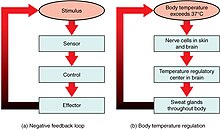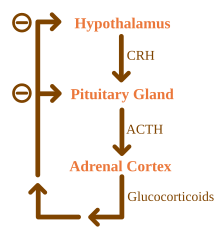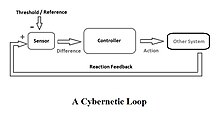A simple negative feedback system descriptive, for example, of some electronic amplifiers. The feedback is negative if the loop gain AB is negative.
Negative feedback (or balancing feedback) occurs when some function of the output of a system, process, or mechanism is fed back
in a manner that tends to reduce the fluctuations in the output,
whether caused by changes in the input or by other disturbances.
Whereas positive feedback tends to lead to instability via exponential growth, oscillation or chaotic behavior, negative feedback generally promotes stability. Negative feedback tends to promote a settling to equilibrium, and reduces the effects of perturbations. Negative feedback loops in which just the right amount of correction is applied with optimum timing can be very stable, accurate, and responsive.
Negative feedback is widely used in mechanical and electronic engineering, and also within living organisms,
and can be seen in many other fields from chemistry and economics to
physical systems such as the climate. General negative feedback systems
are studied in control systems engineering.
Negative feedback loops also play an integral role in maintaining
the atmospheric balance in various systems on Earth. One such feedback
system is the interaction between solar radiation, cloud cover, and planet temperature.
Blood
glucose levels are maintained at a constant level in the body by a
negative feedback mechanism. When the blood glucose level is too high,
the pancreas secretes insulin and when the level is too low, the
pancreas then secretes glucagon. The flat line shown represents the
homeostatic set point. The sinusoidal line represents the blood glucose
level.
Examples
- Mercury thermostats (circa 1600) using expansion and contraction of columns of mercury in response to temperature changes were used in negative feedback systems to control vents in furnaces, maintaining a steady internal temperature.
- In the invisible hand of the market metaphor of economic theory (1776), reactions to price movements provide a feedback mechanism to match supply and demand.
- In centrifugal governors (1788), negative feedback is used to maintain a near-constant speed of an engine, irrespective of the load or fuel-supply conditions.
- In a steering engine (1866), power assistance is applied to the rudder with a feedback loop, to maintain the direction set by the steersman.
- In servomechanisms, the speed or position of an output, as determined by a sensor, is compared to a set value, and any error is reduced by negative feedback to the input.
- In audio amplifiers, negative feedback reduces distortion, minimises the effect of manufacturing variations in component parameters, and compensates for changes in characteristics due to temperature change.
- In analog computing feedback around operational amplifiers is used to generate mathematical functions such as addition, subtraction, integration, differentiation, logarithm, and antilog functions.
- In a phase locked loop (1932) feedback is used to maintain a generated alternating waveform in a constant phase to a reference signal. In many implementations the generated waveform is the output, but when used as a demodulator in an FM radio receiver, the error feedback voltage serves as the demodulated output signal. If there is a frequency divider between the generated waveform and the phase comparator, the device acts as a frequency multiplier.
- In organisms, feedback enables various measures (e.g. body temperature, or blood sugar level) to be maintained within a desired range by homeostatic processes.
History
Negative feedback as a control technique may be seen in the refinements of the water clock introduced by Ktesibios
of Alexandria in the 3rd century BCE. Self-regulating mechanisms have
existed since antiquity, and were used to maintain a constant level in
the reservoirs of water clocks as early as 200 BCE.
The fly-ball governor is an early example of negative feedback.
Negative feedback was implemented in the 17th Century. Cornelius Drebbel had built thermostatically-controlled incubators and ovens in the early 1600s,
and centrifugal governors were used to regulate the distance and pressure between millstones in windmills. James Watt patented a form of governor in 1788 to control the speed of his steam engine, and James Clerk Maxwell
in 1868 described "component motions" associated with these governors
that lead to a decrease in a disturbance or the amplitude of an
oscillation.
The term "feedback" was well established by the 1920s, in reference to a means of boosting the gain of an electronic amplifier.
Friis and Jensen described this action as "positive feedback" and made
passing mention of a contrasting "negative feed-back action" in 1924.
Harold Stephen Black came up with the idea of using negative feedback in electronic amplifiers in 1927, submitted a patent application in 1928, and detailed its use in his paper of 1934, where he defined negative feedback as a type of coupling that reduced the gain of the amplifier, in the process greatly increasing its stability and bandwidth.
Karl Küpfmüller published papers on a negative-feedback-based automatic gain control system and a feedback system stability criterion in 1928.
Nyquist and Bode built on Black’s work to develop a theory of amplifier stability.
Early researchers in the area of cybernetics subsequently generalized the idea of negative feedback to cover any goal-seeking or purposeful behavior.
All purposeful behavior may be considered to require negative feed-back. If a goal is to be attained, some signals from the goal are necessary at some time to direct the behavior.
Cybernetics pioneer Norbert Wiener
helped to formalize the concepts of feedback control, defining feedback
in general as "the chain of the transmission and return of
information", and negative feedback as the case when:
The information fed back to the control center tends to oppose the departure of the controlled from the controlling quantity...
While the view of feedback as any "circularity of action" helped to keep the theory simple and consistent, Ashby
pointed out that, while it may clash with definitions that require a
"materially evident" connection, "the exact definition of feedback is
nowhere important". Ashby pointed out the limitations of the concept of "feedback":
The concept of 'feedback', so simple and natural in certain elementary cases, becomes artificial and of little use when the interconnections between the parts become more complex...Such complex systems cannot be treated as an interlaced set of more or less independent feedback circuits, but only as a whole. For understanding the general principles of dynamic systems, therefore, the concept of feedback is inadequate in itself. What is important is that complex systems, richly cross-connected internally, have complex behaviors, and that these behaviors can be goal-seeking in complex patterns.
To reduce confusion, later authors have suggested alternative terms such as degenerative, self-correcting, balancing, or discrepancy-reducing in place of "negative".
Overview
Feedback loops in the human body
In many physical and biological systems, qualitatively different
influences can oppose each other. For example, in biochemistry, one set
of chemicals drives the system in a given direction, whereas another set
of chemicals drives it in an opposing direction. If one or both of
these opposing influences are non-linear, equilibrium point(s) result.
In biology, this process (in general, biochemical) is often referred to as homeostasis; whereas in mechanics, the more common term is equilibrium.
In engineering, mathematics and the physical, and biological sciences, common terms for the points around which the system gravitates include: attractors, stable states, eigenstates/eigenfunctions, equilibrium points, and setpoints.
In control theory, negative
refers to the sign of the multiplier in mathematical models for
feedback. In delta notation, −Δoutput is added to or mixed into the
input. In multivariate systems, vectors help to illustrate how several
influences can both partially complement and partially oppose each
other.
Some authors, in particular with respect to modelling business systems, use negative to refer to the reduction in difference between the desired and actual behavior of a system. In a psychology context, on the other hand, negative refers to the valence of the feedback – attractive versus aversive, or praise versus criticism.
In contrast, positive feedback
is feedback in which the system responds so as to increase the
magnitude of any particular perturbation, resulting in amplification of
the original signal instead of stabilization. Any system in which there
is positive feedback together with a gain greater than one will result
in a runaway situation. Both positive and negative feedback require a
feedback loop to operate.
However, negative feedback systems can still be subject to oscillations.
This is caused by the slight delays around any loop. Due to these
delays the feedback signal of some frequencies can arrive one half cycle
later which will have a similar effect to positive feedback and these
frequencies can reinforce themselves and grow over time. This problem is
often dealt with by attenuating or changing the phase of the
problematic frequencies. Unless the system naturally has sufficient
damping, many negative feedback systems have low pass filters or dampers fitted.
Some specific implementations
There are a large number of different examples of negative feedback and some are discussed below.
Error-controlled regulation
Basic error-controlled regulator loop
A regulator R adjusts the input to a system T so the monitored essential variables E are held to set-point values S that result in the desired system output despite disturbances D.
One use of feedback is to make a system (say T) self-regulating to minimize the effect of a disturbance (say D). Using a negative feedback loop, a measurement of some variable (for example, a process variable, say E) is subtracted from a required value (the 'set point') to estimate an operational error in system status, which is then used by a regulator (say R) to reduce the gap between the measurement and the required value. The regulator modifies the input to the system T
according to its interpretation of the error in the status of the
system. This error may be introduced by a variety of possible
disturbances or 'upsets', some slow and some rapid. The regulation in such systems can range from a simple 'on-off' control to a more complex processing of the error signal.
It may be noted that the physical form of the signals in the
system may change from point to point. So, for example, a change in
weather may cause a disturbance to the heat input to a house (as an example of the system T) that is monitored by a thermometer as a change in temperature (as an example of an 'essential variable' E), converted by the thermostat (a 'comparator') into an electrical error in status compared to the 'set point' S, and subsequently used by the regulator (containing a 'controller' that commands gas control valves and an ignitor) ultimately to change the heat provided by a furnace (an 'effector') to counter the initial weather-related disturbance in heat input to the house.
Error controlled regulation is typically carried out using a Proportional-Integral-Derivative Controller (PID controller).
The regulator signal is derived from a weighted sum of the error
signal, integral of the error signal, and derivative of the error
signal. The weights of the respective components depend on the
application.
Mathematically, the regulator signal is given by:
where
- is the integral time
- is the derivative time
Negative feedback amplifier
The negative feedback amplifier was invented by Harold Stephen Black at Bell Laboratories in 1927, and granted a patent in 1937 (US Patent 2,102,671 "a continuation of application Serial No. 298,155, filed August 8, 1928 ...").
- "The patent is 52 pages long plus 35 pages of figures. The first 43 pages amount to a small treatise on feedback amplifiers!"
There are many advantages to feedback in amplifiers. In design, the type of feedback and amount of feedback are carefully selected to weigh and optimize these various benefits.
Advantages of negative voltage feedback in amplifiers are-
1) It reduces non linear distortion that is it has higher fidelity. 2) It increases circuit stability that is the gain remains stable though
there are variations in ambient temperature, frequency and signal amplitude.
3) It increases bandwidth that is the frequency response is improved.
4) It is possible to modify the input and output impedances.
5) The harmonic distortion, phase distortion are less.
6) The amplitude and frequency distortion are less.
7) Noise is reduced considerably.
8) An important advantage of negative feedback is that it stabilizes the gain.
Though negative feedback has many advantages, amplifiers with feedback can oscillate. See the article on step response. They may even exhibit instability. Harry Nyquist of Bell Laboratories proposed the Nyquist stability criterion and the Nyquist plot that identify stable feedback systems, including amplifiers and control systems.
Negative feedback amplifier with external disturbance. The feedback is negative if βA >0.
The figure shows a simplified block diagram of a negative feedback amplifier.
The feedback sets the overall (closed-loop) amplifier gain at a value:
where the approximate value assumes βA >> 1. This
expression shows that a gain greater than one requires β < 1. Because
the approximate gain 1/β is independent of the open-loop gain A, the feedback is said to 'desensitize' the closed-loop gain to variations in A
(for example, due to manufacturing variations between units, or
temperature effects upon components), provided only that the gain A is sufficiently large. In this context, the factor (1+βA) is often called the 'desensitivity factor', and in the broader context of feedback effects that include other matters like electrical impedance and bandwidth, the 'improvement factor'.
If the disturbance D is included, the amplifier output becomes:
which shows that the feedback reduces the effect of the disturbance by the 'improvement factor' (1+β A). The disturbance D
might arise from fluctuations in the amplifier output due to noise and
nonlinearity (distortion) within this amplifier, or from other noise
sources such as power supplies.
The difference signal I–βO at the amplifier input is sometimes called the "error signal". According to the diagram, the error signal is:
From this expression, it can be seen that a large 'improvement factor' (or a large loop gain βA) tends to keep this error signal small.
Although the diagram illustrates the principles of the negative feedback amplifier, modeling a real amplifier as a unilateral forward amplification block and a unilateral feedback block has significant limitations. For methods of analysis that do not make these idealizations, see the article Negative feedback amplifier.
Operational amplifier circuits
A feedback voltage amplifier using an op amp with finite gain but infinite input impedances and zero output impedance.
The operational amplifier was originally developed as a building block for the construction of analog computers, but is now used almost universally in all kinds of applications including audio equipment and control systems.
Operational amplifier circuits typically employ negative feedback
to get a predictable transfer function. Since the open-loop gain of an op-amp
is extremely large, a small differential input signal would drive the
output of the amplifier to one rail or the other in the absence of
negative feedback. A simple example of the use of feedback is the op-amp
voltage amplifier shown in the figure.
The idealized model of an operational amplifier assumes that the
gain is infinite, the input impedance is infinite, output resistance is
zero, and input offset currents and voltages are zero. Such an ideal
amplifier draws no current from the resistor divider.
Ignoring dynamics (transient effects and propagation delay),
the infinite gain of the ideal op-amp means this feedback circuit
drives the voltage difference between the two op-amp inputs to zero. Consequently, the voltage gain of the circuit in the diagram, assuming an ideal op amp, is the reciprocal of feedback voltage division ratio β:
- .
A real op-amp has a high but finite gain A at low frequencies,
decreasing gradually at higher frequencies. In addition, it exhibits a
finite input impedance and a non-zero output impedance. Although
practical op-amps are not ideal, the model of an ideal op-amp often
suffices to understand circuit operation at low enough frequencies.
As discussed in the previous section, the feedback circuit stabilizes
the closed-loop gain and desensitizes the output to fluctuations
generated inside the amplifier itself.
Mechanical engineering
The ballcock or float valve uses negative feedback to control the water level in a cistern.
An example of the use of negative feedback control is the ballcock control of water level (see diagram). In modern engineering, negative feedback loops are found in fuel injection systems and carburettors. Similar control mechanisms are used in heating and cooling systems, such as those involving air conditioners, refrigerators, or freezers.
Biology
Control of endocrine hormones by negative feedback.
Some biological systems exhibit negative feedback such as the baroreflex in blood pressure regulation and erythropoiesis. Many biological process (e.g., in the human anatomy) use negative feedback. Examples of this are numerous, from the regulating of body temperature, to the regulating of blood glucose levels. The disruption of feedback loops can lead to undesirable results: in the case of blood glucose levels, if negative feedback fails, the glucose levels in the blood may begin to rise dramatically, thus resulting in diabetes.
For hormone secretion regulated by the negative feedback loop:
when gland X releases hormone X, this stimulates target cells to release
hormone Y. When there is an excess of hormone Y, gland X "senses" this
and inhibits its release of hormone X. As shown in the figure, most endocrine hormones are controlled by a physiologic negative feedback inhibition loop, such as the glucocorticoids secreted by the adrenal cortex. The hypothalamus secretes corticotropin-releasing hormone (CRH), which directs the anterior pituitary gland to secrete adrenocorticotropic hormone (ACTH). In turn, ACTH directs the adrenal cortex to secrete glucocorticoids, such as cortisol.
Glucocorticoids not only perform their respective functions throughout
the body but also negatively affect the release of further stimulating
secretions of both the hypothalamus and the pituitary gland, effectively
reducing the output of glucocorticoids once a sufficient amount has
been released.
Chemistry
Closed systems containing substances undergoing a reversible chemical reaction can also exhibit negative feedback in accordance with Le Chatelier's principle which shift the chemical equilibrium to the opposite side of the reaction in order to reduce a stress. For example in the reaction
- N2 + 3 H2 ⇌ 2 NH3 + 92 kJ/mol
If a mixture of the reactants and products exists at equilibrium in a
sealed container and nitrogen gas is added to this system, then the
equilibrium will shift toward the product side in response. If the
temperature is raised, then the equilibrium will shift toward the
reactant side which, because the reverse reaction is endothermic, will
partially reduces the temperature.
Self-organization
Self-organization is the capability of certain systems "of organizing their own behavior or structure". There are many possible factors contributing to this capacity, and most often positive feedback is identified as a possible contributor. However, negative feedback also can play a role.
Economics
In economics, automatic stabilisers are government programs that are intended to work as negative feedback to dampen fluctuations in real GDP.
Mainstream economics asserts that the market pricing mechanism operates to match supply and demand,
because mismatches between them feed back into the decision-making of
suppliers and demanders of goods, altering prices and thereby reducing
any discrepancy. However Norbert Wiener wrote in 1948:
- "There is a belief current in many countries and elevated to the rank of an official article of faith in the United States that free competition is itself a homeostatic process... Unfortunately the evidence, such as it is, is against this simple-minded theory."
The notion of economic equilibrium being maintained in this fashion by market forces has also been questioned by numerous heterodox economists such as financier George Soros and leading ecological economist and steady-state theorist Herman Daly, who was with the World Bank in 1988-1994.
Environmental Applications
A basic and common example of a negative feedback system in the environment is the interaction among cloud cover, plant growth, solar radiation, and planet temperature.
As incoming solar radiation increases, planet temperature increases. As
the temperature increases, the amount of plant life that can grow
increases. This plant life can then make products such as sulfur which
produce more cloud cover. An increase in cloud cover leads to higher albedo, or surface reflectivity, of the Earth. As albedo increases, however, the amount of solar radiation decreases. This, in turn, affects the rest of the cycle.
Cloud cover, and in turn planet albedo and temperature, is also influenced by the hydrological cycle. As planet temperature increases, more water vapor is produced, creating more clouds. The clouds then block incoming solar radiation, lowering the temperature of the planet. This interaction produces less water vapor
and therefore less cloud cover. The cycle then repeats in a negative
feedback loop. In this way, negative feedback loops in the environment
are stabilizing.

























